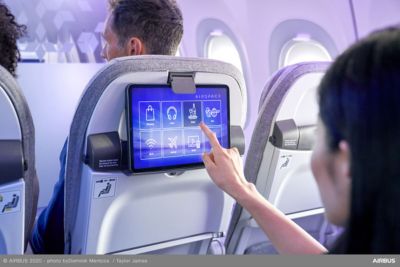-
-
Access Free Student Software
Ansys empowers the next generation of engineers
Students get free access to world-class simulation software.
-
Connect with Ansys Now!
Design your future
Connect with Ansys to explore how simulation can power your next breakthrough.
Countries & Regions
Free Trials
Products & Services
Learn
About
Back
Products & Services
Back
Learn
Ansys empowers the next generation of engineers
Students get free access to world-class simulation software.
Back
About
Design your future
Connect with Ansys to explore how simulation can power your next breakthrough.
Free Trials
ANSYS BLOG
April 25, 2023
Ansys Supports Smarter In-Cabin Communications for Airbus
You anticipate landing in Pittsburgh in an hour. Then you hear an announcement from the pilot that your flight will be delayed. No problem. You can share the delay with whoever is waiting for you at the airport via your mobile device from the runway. Or open the Uber app, catch a ride and save someone else the trouble of picking you up. Maintaining this level of connectedness has become an essential part of daily life, both personally and professionally — whether you’re signing up for a last-minute parent-teacher conference, tweaking a presentation for an important meeting on the fly, or adjusting your thermostat on the way home for a comfy arrival.
Over the coming years, consumer expectations for connectivity will continue to extend to the Internet of Things (IoT) as we develop and integrate more smart devices into our lives. It’s a trend that promises to revolutionize aviation — more specifically, the aircraft cabin — from temperature control to coffee machines to entertainment experiences.
All of these smart technologies are managed by a network of in-cabin and sensor technologies working together simultaneously to improve passenger safety, in-flight experiences, and comfort. They’re also key differentiators for first-class aircraft manufacturer Airbus as part of its connected cabin experience for commercial air travel, Airspace Link — made possible, in part, with support from Ansys software.

Taking Product-Centric Approach to Cybersecurity with Simulation
Central to Airbus’ connected experience is their Airspace Link intelligent Core Management Platform (iCMP), a cabin management system (CMS) that provides the interface for cabin crews to monitor and control all aircraft functions related to the cabin. It’s what Airbus describes as “the digital backbone” of the Airspace Link eco-system responsible for cabin management and is a replacement for its Cabin Intercommunication Data System (CIDS).
iCMP provides the infrastructure needed for a digital smart platform that enables data access and management, content hosting, and cabin management controls. The goal of the iCMP is to support a single, central platform that integrates the openness, flexibility, and efficiency necessary to make important connections.
Until recently, CMS’ have generally been designed to achieve aviation safety objectives, while putting all other requirements second. During the development phase, Ansys simulation enabled a more product-centric approach, where each and every CMS is hand-crafted for a specific plane. A more product-based focus helps Airbus enhance cybersecurity in step with the evolution of passenger electronics and related ecosystems. It’s part of a more ambitious streamlining effort over all CMS product lines.
Ansys Software Enables a More Flexible and Agile Connected Cabin
The biggest challenge is designing a new system-scalable platform from scratch in a reduced timeline (an initial implementation is targeted for 2024) that could support decades of aircraft operation. Ansys SCADE provides a flexible and agile platform to enable Airbus to successfully implement new connected technology for future cabin configuration.
Lead time, complexity, and complying with safety regulations presented formidable challenges during development, compounded by software development increases at the DO-178C Design Assurance Level (DAL), more specially DAL B pertaining to smoke detection. DO-178C, Software Considerations in Airborne Systems and Equipment Certification, is the gold standard for Federal Aviation Administration (FAA), European Union Aviation Safety Administration (EASA), and Transport Canada approval of commercial software-based aerospace systems.
To do this, Airbus needed a solution that could reduce test activity, speed up and make agile the certified embedded verification process, reduce internal effort for tool qualification, and support the code generator long term. This was accomplished using the latest version of SCADE — leveraging the most recent developments and advanced features the model-based development environment has to offer.

All System Requirements Go with Ansys SCADE
SCADE meets all system requirements, delivering a complete workflow from design to verification with a certified code generation, while reducing software development costs. Using the software helps in speeding up embedded software design, resulting in significant program time gains. It also facilitated a certified, model-based process for safety improvement.
Thanks to SCADE, Airbus can deliver the iCMP key capabilities for the cabin management system, such as smoke detection, which is one of the most safety-critical functions in the cabin, and increased cybersecurity.
Digital Transformation on the Horizon
In the future Ansys SCADE will be connected with Airbus’ Digital Design, Manufacturing and Services (DDMS) approach to aerospace design, manufacturing and operation, the manufacturer’s digital transformation program. Ansys SCADE’s model-based approach for embedded software fully aligns with the company's DDMS approach because it ensures digital continuity between requirements, systems, and software engineering.
The purpose of this software is to realize major breakthroughs and changes to design, manufacturing, and product support; accelerate timelines that can better adapt to industrial product rates; secure operational performance and industrial maturity; reduce product development lead times leading to increase value; and realize increased customer satisfaction due to the flexibility of later-stage customization.